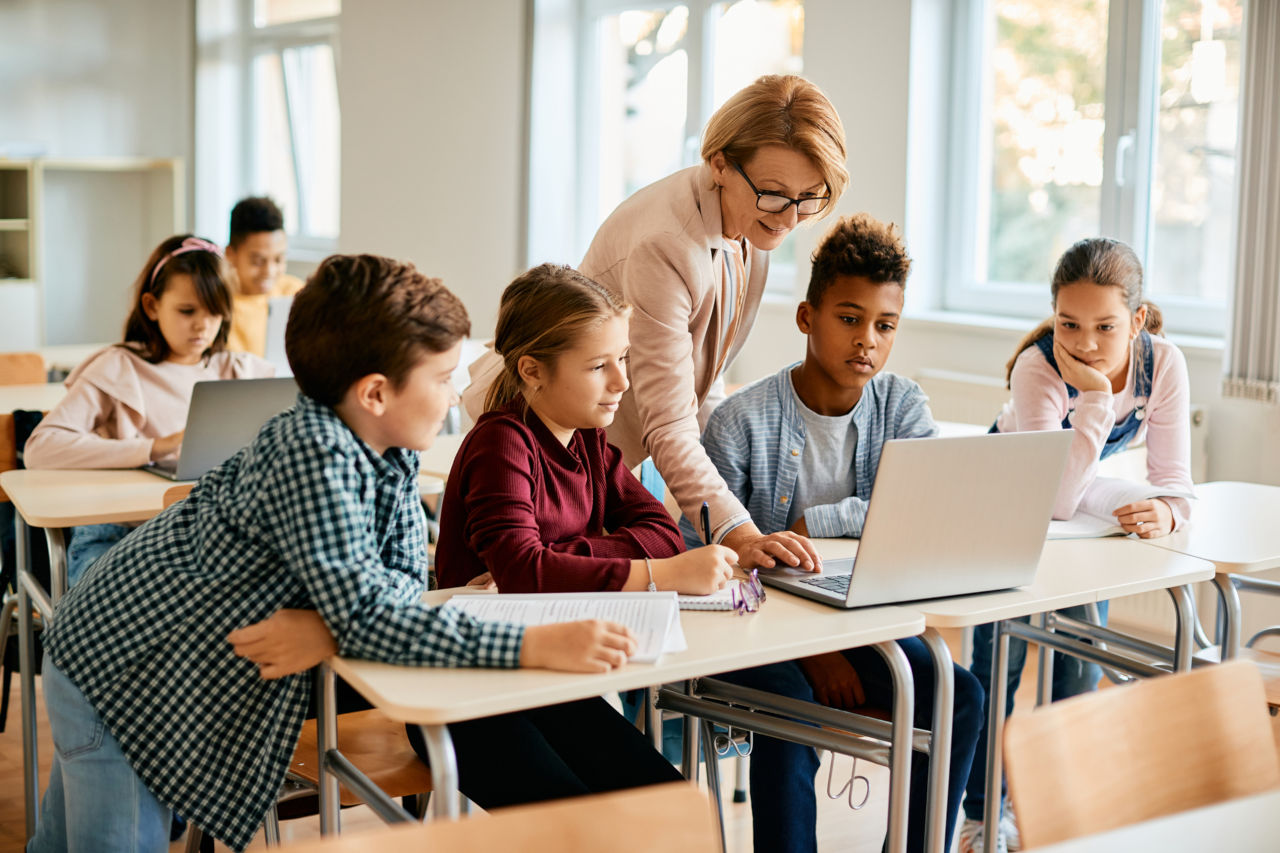Top Sites for Differentiated Instruction
These online platforms offer a wide variety of tools to help teachers differentiate instruction in their classrooms

Teachers have always known their students aren’t all working at the same level. Yet for teachers to adjust lesson plans manually for each child seems a daunting task, given that there are only 24 hours in a day. Here’s where education technology tools really shine. Using online digital platforms that combine formative assessment, lesson plans, quizzes, progress tracking, and artificial intelligence, educators can easily adjust instruction for an entire classroom of kids at once.
The following websites for differentiated instruction offer a wide variety of methods to differentiate teaching and learning for any budget.
Top Free Sites for Differentiated Instruction
Readworks
An award-winning platform that provides free literacy resources for learners of any age. But “resources” does not do justice to ReadWork’s breadth of research-based, standards-aligned literacy content, which is buttressed by robust guidance for teachers. Create your free account and then explore features including lesson differentiation, assignments, assessment and progress monitoring. Integrates with Google classroom.
SplashLearn
A free-for-educators game-based platform teaching math and English, SplashLearn offers thousands of preK-5 curriculum-aligned English and math games, as well as differentiated practice goals, lesson plans and comprehensive progress reports. The website features a well-designed interface, allowing users to easily search for content by grade and topic. Compatible with most devices.
For the Teachers: Differentiated Reading Lessons
A step-by-step guide to creating differentiated reading lessons for students in grades 3-10 based on a selection of articles written at three levels of literacy. Detailed PDF lesson plans, ideas, and charts provide strong direction for implementation in the classroom. Suggestion: Ignore the balky heading links at the top of the article in favor of simply scrolling down the page.
Differentiated Instruction Strategies and Examples
After a brief discussion of differentiated instruction strategies, this article from HMH examines in detail 20 diverse ways teachers can differentiate instruction. With methods ranging from choice boards to tiered assignments to flipped classrooms, there’s something for every style of teaching.
Read Write Think Differentiating Instruction
Read Write Think has developed a comprehensive series of guides detailing strategies for differentiation in the classroom, from assessment to cooperative learning to the think-pair-share technique. Each guide includes the research basis for the strategy, how to implement it, and lesson plans. A must-have for your differentiated teaching.
Tools and ideas to transform education. Sign up below.
Classtools.net
The brainchild of educator Russel Tarr, Classtools.net allows teachers to create games, quizzes, activities, and diagrams for creative differentiated learning. Don’t be fooled by Classtools.net’s simple layout -- this site is a powerhouse of free, fun, and easy-to-use tools for teaching and learning, many of which are not found elsewhere. Try the Tarsia Puzzle Generator, Dice Roller, or Turbo Timeline Generator. Don’t worry: “Fling the Teacher” is all in good fun.
Breaking News English
A remarkable free site that transforms current events into rich classroom lessons for learners of any ability. Each news article is written at four different reading levels and accompanied by online grammar, spelling, and vocabulary activities as well as printable worksheets. Students can also listen to audio at five speeds for each article. Ideal for ELL students or simply differentiating English lessons.
Rewordify.com
Very cool free site that “rewordifies” by simplifying difficult text, from classic literature (Lewis Carroll, William Shakespeare, Harriet Beecher Stowe, e.g.) to historical documents and modern internet articles. Users can upload their own text or URL, or browse existing content. Be sure to check out the printable vocabulary exercises and quizzes, and the Educator Central department, which allows teachers to add student accounts and track progress.
Top Freemeum Sites for Differentiated Instruction
NoRedInk
An ELA platform designed to build writing and critical thinking skills, NoRedInk allows teachers to build engaging personalized exercises, scaffolded writing activities, and standards-aligned assignments. The free version includes a teacher dashboard, text-to-speech function for students, and limited scalable lessons and activities. The premium account allows for thousands of skill practice activities, writing prompts, and hundreds of guided draft prompts.
CommonLit
A research-backed, tiered program from the non-profit organization CommonLit that provides reading lessons and assessments for students in grades 3-12. The robust free account option offers the entire digital library of books as well as the CommonLit 360 curriculum for educators, who must sign up with a school email account. Teachers can differentiate lessons by text selection, annotation and/or by varying assessments. Three other packages designed for entire schools add rostering integrations, professional development and other features.
Quill
The not-for-profit Quill is dedicated to providing free tools to help students improve their reading, writing, and critical thinking skills. Start with the diagnostic tests to assess your students’ learning. A strong set of tutorials will guide teachers and students in making the most of Quill.
Arcademics
K-8 game-based learning across a wide range of subjects. The educational portal allows teachers to track and monitor students, generate detailed reports, and assess student learning.
ClassroomQ
This easy-to-use, innovative platform acts as a digital hand-raising device, making it easy for kids to ask for help and for teachers to provide it in a timely fashion.
Pear Deck
A Google Slides add-on that allows educators to create quizzes, slides, and presentations with their own content or using templates. Students respond via their mobile devices; teachers can then assess student understanding in real time.
Actively Learn
Educators can make any reading material their own by adding questions and annotation. The “Extra Help” features supports differentiated learning by offering explanatory text when needed. Integrates with Google Classroom and Canvas.
Top Premium Sites for Differentiated Instruction
Membean
A popular digital vocabulary teaching tool that includes built-in differentiation, Membeam takes an uncommon approach to vocabulary memorization, emphasizing practice via memory retrieval rather than memory encoding. In addition, Membeam focuses on spaced practice (in contrast to “cramming”) as well as promoting higher-order thinking. Pricing ranges from $6-$20 per student, depending on the number of students. Free trials are available.
Renzulli Learning
Founded by education researchers, Renzulli Learning is a learning system that differentiates instruction for any student through careful assessment of student learning style, preferences, and creativity. Integrates with Clever, ClassLink, and other SSO providers. A generous 90-day free trial makes it easy to try it yourself.
IXL
A popular site for English language arts, science, social studies, and Spanish that allows student progress tracking with detailed reporting. Educators can monitor areas in which students struggle, and then adjust instruction accordingly.
Buncee
A blended interactive learning tool for creating shareable presentations or digital stories, Buncee includes an extensive multimedia library to enrich your slideshows. Teachers can also flip a classroom by assigning quizzes, plus track and monitor students. 30-day free trial, no credit card required.
Otus
A one-to-one learning management solution and mobile learning environment through which educators can differentiate instruction based on detailed real-time analytics.
Parlay
Teachers can use Parlay to build a classroom discussion on any topic. Browse through a robust library of discussion prompts (with resources), facilitate online round tables, or create a live verbal round table. Use the built-in tools to provide feedback and assess student progress. Free trial for teachers.
Socrates
A standards-aligned, game-based learning system dedicated to differentiated learning that automatically adjusts content to student needs.
Tech & Learning editor and contributor since 2010, Diana is dedicated to ferreting out the best free and low-cost tech tools for teachers.
